February 2005 // Volume 43 // Number 1 // Feature Articles // 1FEA1
Extension as a Delivery System for Prevention Programming: Capacity, Barriers, and Opportunities
Abstract
Implementation of programs that have demonstrated effects on risk and
protective factors offers the best chance for documenting long-term program
impacts and, in turn, for obtaining sustained funding. Our study explored
the capacity of Extension to serve as a delivery system for best practice
programs. In a statewide survey of Family Living and 4-H personnel, we
assessed perceptions about such programs and Extension's role in delivering
them. Results indicate that Extension has significant strengths as a delivery
system for best practice programs. Capacity will be enhanced by reducing
the perceived dichotomy between "prevention" programming and "traditional" Extension
programming.
The historical function of Extension is to bring research-based knowledge in a useable form to groups, families, and individuals in local communities. Extension personnel provide an important bridge between university researchers and community knowledge-users by being able, first, to identify community needs, and second, to select, translate, and transmit relevant, research-based information to help address those needs (Russell, 1991).
Traditionally, Extension 4-H youth and family personnel have created their own curricula or made use of programs and curricula developed by other Extension agents and specialists across the nation. Increasingly, however, granting agencies at state and federal levels are requiring that programs chosen for funding be designated as "model" or "best practice" programs whose effectiveness has been demonstrated through replicated, randomized, clinical trials. One example is the Strengthening Families Program, developed at Iowa State University and supported by 9 years of longitudinal research that clearly documents program effectiveness (Spoth, Redmond, Trudeau & Shin, 2002). Because a growing percentage of Extension activities are funded by outside grants or through collaborations with agencies using outside grants, it would be beneficial to incorporate such best practice prevention programs systematically into Extension youth and family offerings.
We conducted a survey of all Family Living and 4-H personnel and county chairs employed by Washington State University Extension. The survey was designed to explore attitudes toward both prevention programs serving youth and families (generally, issue-specific, time-limited, evidence-based "best practice" programs) and traditional Extension programs (generally, ongoing skill and character building curricula and activities in the form of clubs or after-school programs).
Many of the programs we refer to as "traditional" are similar to or overlap in content, methods, and goals with the programs we refer to as "prevention" programs. However, the two categories differ in some respects, most notably in their historical development. In the eyes of funders, the primary differences are that evidence-based "prevention" programs are based in formal developmental theory and in empirical research on risk and protective factors; they have been demonstrated effective in research trials; and they have met specific criteria in order to be designated "best practice."
Numerous studies over the past decade (Basch, 1984; Beebe, Harrison, Sharma, & Hedger, 2001; Orlandi, 1986; Plested et al., 1999) have demonstrated that successful delivery of prevention programs is related to system "readiness"--that is, in order for a new program to be effectively disseminated, the organization or community implementing it must:
- Perceive a need for prevention of specific issues,
- Be able to identify programs that will address that need, and
- Have adequate knowledge, skills, and resources to implement and sustain the program.
The primary goal of our survey was to determine the readiness of Washington's Extension system to incorporate best practice programming into its standard repertoire of volunteer training and program delivery. Drawing on the findings of previous studies of readiness, we explored participants' assessment of community needs, attitudes, and beliefs about prevention programs, and knowledge and skills required to deliver prevention programs. We also assessed whether participants felt that they had the resources necessary to implement such programs, including collaborative relationships, time and money, and organizational support.
The present investigation extends previous literature in two ways. First, although there are some research reports on Extension's delivery of specific types of prevention programs such as teen pregnancy (e.g., Johns, Moncloa, & Gong, 2000) or substance abuse (e.g., Goldberg, Spoth, Meek, & Molgaard, 2001), we found only one report that discussed the potential role of Extension as a delivery system for evidence-based prevention programs (Molgaard, 1997). Results from the present study provide important information about strengths of the system in one state with regard to implementing best practice prevention programs as well as information about barriers to implementation.
Second, there are a number of articles related to differences in attitudes between practitioners and researchers (e.g., Myers-Walls, 2000). However, our literature search revealed no information about attitudes of Extension personnel to specific types of prevention programs or to prevention programs generally, about perceived readiness to deliver such programs, or about preferences with regard to traditional Extension offerings versus designated best-practice prevention programming. The present study is therefore the first report of attitudes and perceptions of Extension personnel with respect to these two types of programs. Finally, the survey process and content may serve as a reference for other states interested in exploring readiness in their own Extension systems.
Method
Sample
Our sample included all Extension faculty and program staff whose work involved 4-H, Family Living, or both areas. In addition, we surveyed all county chairs. Eligible personnel were identified through mailing lists maintained by state-level Extension personnel in the 4-H and Family living areas and by review of the statewide Extension personnel directory. The original mailing went to 149 individuals, of whom 16 were found to be ineligible to fill out the survey due to retirement, leave of absence, changing of jobs, or our misidentification of their jobs. The total eligible sample was thus 133 individuals, of whom 110 (83%) completed the survey within 6 weeks of the initial mailing.
The eligible sample included 39 county chairs, 39 faculty, and 55 program staff. Of these, 33 (85%) of the chairs, 35 (90%) of the faculty, and 42 (76%) of the program staff returned the survey. By program area, the sample included 77 4-H personnel, 27 Family Living, and 10 identified as both 4-H and Family Living. An additional 19 (all county chairs) were from other program areas (e.g., Agriculture). Sixty (78%) of the 4-H personnel, 23 (85%) of Family Living, 10 (100%) 4-H/Family Living, and 17 (90%) of the other program area personnel completed the survey.
Procedure
An initial contact letter, introducing and endorsing the study, was mailed from the state administrative directors of the 4-H and Family Living program areas to all eligible Extension personnel. The survey itself, in addition to an explanatory cover letter and consent form, was then mailed to all participants 4 days later. The initial mailing was followed by a reminder and thank-you postcard (to all participants) 1 week later and by a replacement survey (to non-respondents) 3 weeks later (Dillman, 1991). A $2 incentive and self-addressed stamped envelope (SASE) were included with the initial survey mailing; a SASE was also included with the replacement survey. Survey content and procedures were approved by the Institutional Review Board of Washington State University.
Measures
Overview of Measures
We asked participants to respond to items in several areas, including: perception of need for different types of programs; program effectiveness; the role of Extension in delivering best-practice programming; knowledge and perceived competence; and availability of resources. Within several of these areas we asked about attitudes toward 14 specific types of programs: five types of positive development programs (character building, workforce preparation, social skills development, neighborhood and community attachment, and parent training), and nine types of programs designed to prevent maladaptive outcomes (teen substance abuse, delinquency and aggression, teen pregnancy, school dropout, domestic violence, teen suicide, child abuse and neglect, and deficiencies in prenatal and infant care).
The positive development programs represent the traditional focus of Extension's youth and family programs, and the nine others represent typical best-practice or prevention program focuses. Factor analyses clearly indicated separate factors for the "traditional" and the "prevention" programs on items asking participants to rate all programs. The survey items were pilot tested in a series of 12 interviews conducted with Extension personnel.
Perception of Need
Respondents were asked to rate the extent to which they agreed or disagreed that their community needed more programming to address issues associated with specific negative outcomes (teen substance abuse, delinquency and aggression, teen pregnancy, school dropout, domestic violence, teen suicide, child abuse and neglect, and deficiencies in prenatal and infant care) as well as issues associated with the more positive outcomes traditionally targeted by Extension programs (character building, workforce preparation, social skills development, neighborhood and community attachment, and parent training). Agreement was rated on a five-point Likert-type scale.
Factor analyses on this set of items indicated that the negative outcome items constituted one factor ("Problem Outcomes") and the positive outcome items constituted a second factor ("Positive Outcomes"). Cronbach's alpha for the Problem Outcome scale was .92 and for the Positive Outcome scale .84. Thus, it is clear that these types of programs are perceived as falling into two distinct categories by survey respondents.
Program Effectiveness
We asked respondents to rate the effectiveness of both issue-specific prevention programs and traditional Extension programs in preventing teen substance abuse, dropout, aggression, and the remaining negative outcomes. Factor analysis yielded two scales, one related to effectiveness of skills-based programs (Cronbach's alpha = .86) and the other to effectiveness of prevention programs (Cronbach's alpha = .94). Items were rated on a five-point Likert-type scale.
Extension's Role
We asked respondents to rate their agreement with the following statements: "Traditional Extension activities and curricula focused on positive development and skill building may need to be supplemented by programs addressing specific topics (such as substance abuse or teen pregnancy prevention) in order to fulfill our Extension system's vision for children, youth, and families," and "Traditional Extension activities and curricula focused on positive development and skill building should be replaced by programs addressing specific topics (such as substance abuse or teen pregnancy prevention) in order to fulfill our Extension system's vision for children, youth, and families."
Knowledge and Competence
We measured respondents' perception of their knowledge and competence with a series of nine items rated on a five-point Likert-type scale. Factor analysis yielded two factors: one comprised of two items indicating general theoretical knowledge about child and family development (Cronbach's alpha = .84), the other indicating perceived knowledge and abilities related to prevention programming, such as risk and protective factors, identifying and implementing evidence-based programs, conducting program evaluation, and obtaining funding (Cronbach's alpha = .89). In this article we report on the items specifically related to prevention programming.
Adequacy of Resources
We measured respondents' perceptions about their degree of collaboration with local, state, and federal agencies and organizations; availability of resources; and organizational support. Many of the resource items were taken directly or modified from a national study of the capacity of Cooperative Extension to serve children, youth and families (Betts, Peterson, Marczak, & Richmond, 2001; Marczak, Peterson, Betts, & Earthman, 1999).
Results
For ease of interpretation, we collapsed the five-point Likert-type scales into three categories: "Agree," "Neutral," and "Disagree."
Attitudes and Beliefs
Need
A majority of respondents felt that there was a need in their communities for prevention programs to address each of the problem outcomes described. For example, between 55% and 70% perceived a local need for prevention programs addressing teen substance use and abuse, pregnancy, dropout, suicide, and aggression (Figure 1).
Figure 1.
Perception of Need for Prevention Programming in Community

Effectiveness
Between one-half to two-thirds of respondents felt that prevention programs are effective in addressing the problem outcomes. In many cases, however, nearly as many respondents felt that traditional Extension programs are also effective in preventing the same problems (Figure 2). For example, 75% felt that issue-specific prevention programs are effective in preventing teen substance abuse, but 68% felt that traditional Extension programs are also effective in this regard. In prevention of child abuse, domestic abuse, and in prenatal and infant care, however, issue-specific programs were rated as significantly more effective (p< .05).
Figure 2.
Perceived Effectiveness of Issue-Specific Programs Versus Traditional
Extension Programs
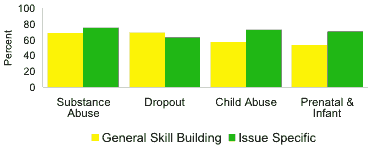
Extension's Role
A majority of respondents (63%) agreed with the statement that Extension may need to supplement its offerings with prevention programs (Figure 3). An equally strong majority (64%) disagreed with the statement that Extension should replace traditional offerings with prevention programs.
Figure 3.
Supplementing Versus Replacing Traditional Programming with Prevention
Programming
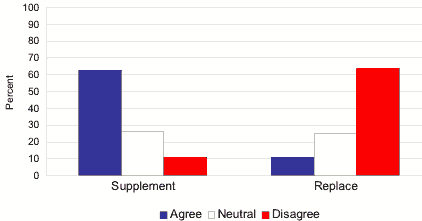
Interest
About half of all respondents expressed interest in learning more about most issue-specific prevention programs (Figure 4). Interest ranged from a low of 34% (prenatal and early infant care programs) to a high of 52% (teen substance abuse programs).
Figure 4.
Levels of Interest in Issue-Specific Programs
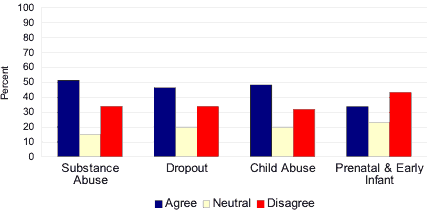
Overall, however, respondents were significantly more interested in learning more about programs with traditional Extension emphases than in learning more about issue-specific programs (t = 5.59, p < .0001). Interest in traditional programs ranged from a low of 57% (parent training programs) to a high of 70% (social skills development; see Figure 5).
Figure 5.
Levels of Interest in Programs with Traditional Extension Emphasis
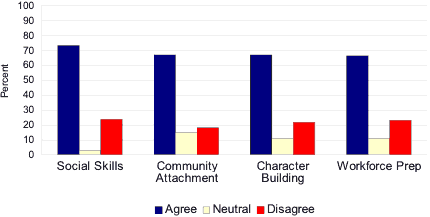
Knowledge and Skills
A strong majority of participants felt that they had general knowledge and skills necessary for successful implementation of prevention programs (Figure 6). For example, 72% reported that they understand risk and resilience factors, and 92% reported feeling comfortable with interactive teaching methods This very high degree of comfort contrasts with members of other professions, especially school teachers, who report a strong preference for non-interactive teaching methods such as lecturing. Interactive methods are associated with positive program outcomes (Ennett et al., 2003), and those who are comfortable with such methods are also more successful in implementing prevention programs (Ringwalt et al., 2003). On the other hand, slightly less than half the respondents agreed that they have skills specifically related to prevention programming, such as an ability to identify prevention programs (47%) or to implement them (48%).
Figure 6.
Knowledge and Skills Relevant to Delivery of Prevention Programming
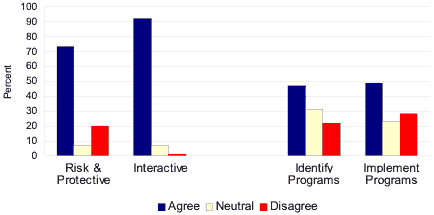
Resources
Organizational Support
Approximately half the respondents (47%) felt that the state Extension system has a clear vision for children, youth, and family programming. Nearly two-thirds felt that the state Extension system has a clear, long-term commitment to children, youth and families (Marczak et al., 1999). Only 21% felt that paid program staff are adequately recognized for their work, but 81% felt strongly supported by their supervisors. Forty percent felt strongly supported by campus faculty.
Time and Money
These resource-related items elicited the strongest level of disagreement of all items on the survey. Over half (55%) disagreed that they had adequate resources (time and money) to engage in collaborative efforts, 72% disagreed that they had resources necessary to match program offerings to community needs, and 44% disagreed that they had adequate resources to conduct evaluations.
Collaboration
An overwhelming majority felt that collaboration with others enhanced the credibility of their own work (87%) and was worth the effort (92%; see Figure 7).
Figure 7.
Attitudes Toward Collaboration in Program Delivery
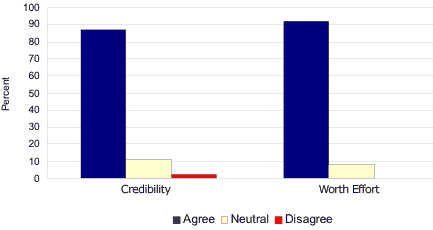
Respondents reported high levels of collaboration with Extension personnel from other counties (46%) and other program areas (48%), community agencies (56%), and schools (45%). Respondents reported a relatively low degree of collaboration with federal agencies (17%), local businesses (14%), and faculty from University departments (11%; see Figure 8).
Figure 8.
Degree of Collaboration with Various Groups
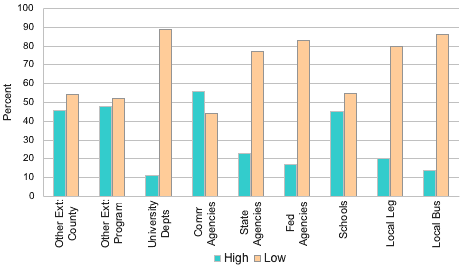
Discussion
A substantial number of Extension professionals expressed positive attitudes towards prevention programs. In general, approximately one half to three quarters of survey respondents:
- Endorsed supplementing traditional 4-H youth and family programming with issue-specific programs,
- Perceived a need for such programming in their communities,
- Expressed interest in learning more about issue-specific programs,
- Believed that prevention programs are effective, and
- Stated that they have the knowledge and skills to deliver such programs.
Very few respondents, however, believed that Extension should replace traditional programming practices with prevention programs (only 10%), and most believed that traditional skills and character building programs are also effective in preventing problems such as teen substance use/abuse, dropout, and child abuse.
Conclusions
Strengths and Barriers Related to Delivery of Prevention Programs
Extension has significant strengths related to delivery of prevention programs, notably the following.
-
Most respondents believed that Extension has a clear vision of and commitment to serving children, youth and families.
-
Almost all felt supported by their supervisors in programming choices.
-
Nearly everyone reported feeling comfortable with an interactive teaching style.
-
Nearly everyone believed in the value of collaboration.
-
Most reported strong collaborative relationships with local schools and community agencies.
Some barriers to delivery of best practice programs through Extension do exist:
-
Limited resources (time and money);
-
Relatively little collaboration with university departments, local business leaders and legislators, and state and federal agencies;
-
Concern that Extension will lose its focus on traditional areas of emphasis if it incorporates issue-specific programs (survey and interview comments); and
-
Perception that prevention programs derive from a "deficit model" and are contrary to Extension's focus on positive development (from written comments).
Implications for Extension
-
Extension personnel have some well-developed skills (e.g., interactive teaching styles and understanding risk and resilience models) that are a good fit for the delivery of best practice prevention programs. We can capitalize on that strength if we learn to articulate it in the context of these new program opportunities.
-
Staff development on the identification and implementation of prevention programs is vital (with fewer than half feeling they had these skills). It would be important to emphasize ways in which professional skills currently used in "traditional" programs connect to the delivery of best practice prevention programs. For example, comfort with interactive teaching methods may be taken for granted by Extension personnel. However, many people currently delivering prevention programs do not possess these skills; this represents a significant asset for Extension relative to some of the usual venues for prevention programs (e.g., schools).
-
In addition, staff need to understand how "traditional" youth and family programs operate in a prevention context (e.g., reduce risks and promote resilience). For example, adult leaders in 4-H clubs often serve as mentors for young people, a well-documented protective factor (Hawkins, Catalano, & Miller, 1992).
-
We need to overcome the tendency to dichotomize "traditional" and "prevention" programs in Extension. If we can consistently integrate and/or recast our traditional programs as prevention programs, we may be better positioned for new external funding. To do this, staff will need to learn new ways of articulating their work in prevention terms.
-
Best practice prevention programs offer an ideal opportunity for integrated Extension and research projects, a goal that is clearly part of the land grant mission but often absent in 4-H youth and family arenas. Prevention programs by design have strong evaluation components that offer applied research opportunities for research faculty and graduate students. Sadly, the lowest percentage of collaboration reported by Extension personnel in the survey was with campus-based faculty. New partnerships will need to be formed and strategies for sharing program funding devised to create successful projects that integrate research and outreach. However, doing so will offer the best chance for documenting long term program impacts and in turn, for sustained funding.
References
Basch, C. E. (1984). Research on disseminating and implementing health education programs in schools. Journal of School Health, 54(6), 57-66.
Beebe, T. J., Harrison, P. A., Sharma, A., & Hedger, S. (2001). The community readiness survey: Development and initial validation. Evaluation Review, 25(1), 55-71.
Betts, S. C., Peterson, D. J., Marczak, M. S., & Richmond, L. S. (2001). System-wide evaluation: Taking the pulse of a national organization serving children, youth, and families at risk. Children's Services: Social Policy, Research, and Practice, 4(2), 87-101.
Dillman, D. A. (1991). The design and administration of mail surveys. Annual Review of Sociology, 17, 225-249.
Ennett, S. T., Ringwalt, C. L., Thorne, J., Rohrbach, L. A., Vincus, A., Simons-Rudolph, A., et al. (2003). A comparison of current practice in school-based substance use prevention programs with meta-analysis findings. Prevention Science, 4(1), 1-14.
Goldberg, C .J., Spoth, R., Meek, J., & Molgaard, V. K. (2001). The Capable Families and Youth Project: Extension-university-community partnerships. Journal of Extension [On-line], 39(3). Available at: http://www.joe.org/joe/2001june/a6.html
Hawkins, J. D., Catalano, R. F., & Miller, J. Y. (1992). Risk and protective factors for alcohol and other drug problems in adolescence and early adulthood: Implications for substance abuse prevention. Psychological Bulletin, 112, 64-105.
Johns, M.J., Moncloa, F., & Gong, E. J. (2000). Teen pregnancy prevention programs: Linking research and practice. Journal of Extension [On-line], 38(4). Available at: http://www.joe.org/joe/2000august/a1.html
Marczak, M. S., Peterson, D. J., Betts, S. C., & Earthman, E. (1999). Cooperative Extension's capacity to support programs for children, youth and families at risk: How to implement the organizational change survey: A step-by-step guide. Tucson, AZ: The University of Arizona, Institute for Children, Youth and Families.
Molgaard, V. K. (1997). The Extension service as key mechanism for research and services delivery for prevention of mental health disorders in rural areas. American Journal of Community Psychology, 25(4), 515-544.
Myers-Walls, J. A. (2000). An odd couple with promise: Researchers and practitioners in evaluation settings, Family Relations: Interdisciplinary Journal of Applied Family Studies, 49, 341-347.
Orlandi, M. A. (1986). The diffusion and adoption of worksite health promotion innovations: an analysis of barriers. Preventive Medicine, 15(5), 522-536.
Plested, B., Smitham, D. M., Jumper-Thurman, P., Oetting, E. R., Edwards, R. W., & Tri-Ethnic Center for Prevention Research, (1999). Readiness for drug use prevention in rural minority communities. Substance Use & Misuse., 34(4-5), 521-544.
Ringwalt, C. L., Ennett, S., Johnson, R., Rohrbach, L. A., Simons-Rudolph, A., Vincus, A., et al. (2003). Factors associated with fidelity to substance use prevention curriculum guides in the nation's middle schools. Health Education & Behavior Vol 30(3) (Jun 2003): 375-391, 30(3), 375-391.
Russell, M. M. (1991). Cooperative Extension and the land-grant university: A futures history. Journal of Extension [On-line], 29(2). Available at: http://www.joe.org/joe/1991summer/fut1.html
Spoth, R. L., Redmond, C., Trudeau L., & Shin C. (2002). Longitudinal substance initiation outcomes for a universal preventive intervention combining family and school programs. Psychology of Addictive Behaviors, 16, 129-134.
